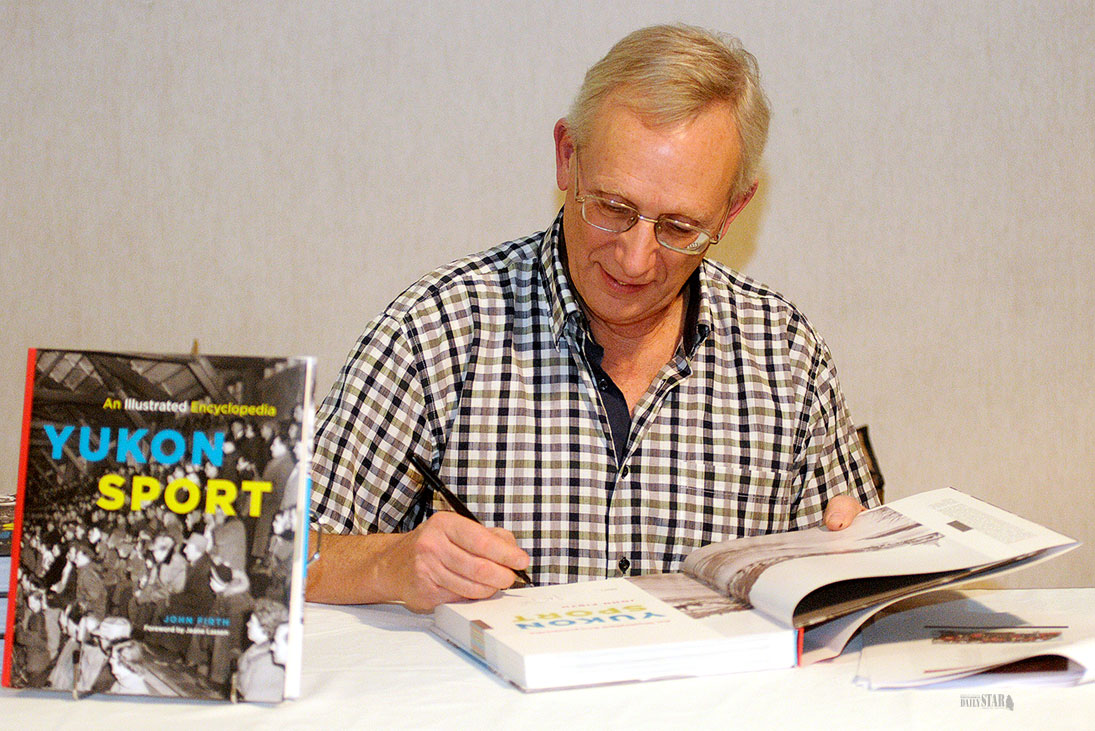
Photo by Marcel Vander Wier
HISTORIC OCCASION – Whitehorse author John Firth autographs a copy of his new book, Yukon Sport: An Illustrated Encyclopedia, at the Sport Yukon Awards Night Nov. 20.

Photo by Marcel Vander Wier
HISTORIC OCCASION – Whitehorse author John Firth autographs a copy of his new book, Yukon Sport: An Illustrated Encyclopedia, at the Sport Yukon Awards Night Nov. 20.
From the 1905 Dawson Nuggets to the annual Yukon Quest, the territory lays claim to some of the most unique stories in Canadian sport.
From the 1905 Dawson Nuggets to the annual Yukon Quest, the territory lays claim to some of the most unique stories in Canadian sport.
Thanks to a partnership between Sport Yukon and local author John Firth, the history of those tales – and many more – is now available in one book.
Released last month, Yukon Sport: An Illustrated Encyclopedia contains 352 pages detailing the ins and outs of the territory’s fabled athletics history.
The idea was an offshoot of last year’s Whitehorse: An Illustrated History, to which Firth contributed a much-smaller version of sports as they related to the Yukon capital.
Firth’s 25,000 words of research were whittled down to 5,000, causing co-author Linda Johnson to tell him: “You have enough here for your own book.”
The comment resonated with Firth, who was commissioned by Sport Yukon president George Arcand shortly thereafter. He was given 18 months to complete the project.
Pressed for time, Firth reached out to Kathy Jones-Gates for assistance, and she spent many hours poring over archives detailing the history of sport in the Klondike.
The result was nearly 100 encyclopedic entries of different sports in the territory.
Firth – a former sports reporter who totalled 10 years over three stints at the Whitehorse Star – was the perfect person to pen the book.
While the lion’s share of the research came with help from the Yukon Archives, Firth also turned to notes from interviews he had conducted over the past 30 years.
“In many ways, the book is a lifetime collection,” Firth explained in a sit-down interview earlier this month. “Often, I was in the right place at the right time.”
During his research, the 61-year-old Firth said many interesting characters came out of the woodwork.
“A lot of people were very instrumental in sports in the Yukon, and sometimes it will surprise you as to who they are,” Firth said.
For instance, the flamboyant character of Klondike Joe Boyle was actually a latecomer to the Dawson Nuggets’ Stanley Cup attempt in 1905, which saw the club travel by dog sled, train and steamer to the nation’s capital, only to get thrashed in two straight games by the Ottawa Silver Seven.
“Boyle got all the glory, but he wasn’t the one who put it together,” said Firth. “The true organizer was actually Jack Eilbeck, which was a surprise. It’s those kind of people who I found the most interesting.”
Another character Firth found spellbinding was Old Crow cross-country skier Martha Benjamin – the only individual athlete to which an entire chapter is dedicated.
Just 25 and already a mother of five, Benjamin became the first Yukoner to win a Canadian championship in 1963, outpacing the entire men’s field on her way to victory in a 10-km race in Ottawa.
She was later invited to compete for Canada in the winter Olympics, but without proper financial support, was unable to attend.
Benjamin’s story is a microcosm of the importance of sport in the small Canadian territory, said Firth.
“Sport was a community builder from the beginning,” he explained.
“Despite class differences, it was the great equalizer. And you can’t talk about athletes who excelled without talking about the community behind them.”
As for the long list of outstanding athletes to come out of the Yukon, Firth said it’s part chance, part training.
With world-class coaches like Olympian Alain Masson teaching young athletes how to cross-country ski, anything becomes possible.
“We’ve got something in the water here, but we also seem to build a better athlete,” said Firth.
“I’m glad I got the chance to put this book together,” he added. “I felt privileged to be able to do this.”
Sport Yukon was happy to partner with Firth on the project.
“There’s no place where our sport history is written,” Arcand explained of the initiative.
Capturing the foundation of sports in the sub-Arctic territory seemed essential to understanding the current Yukon sport landscape, Arcand said.
“While we recognize the Zach Bells and Jeane Lassens of today, there was a tremendous amount of elite athletes that came before them,” he said.
The recent deaths of local sport icons such as hockey coach Jim Fowler and cross-country ski instructor Father Jean-Marie Mouchet made the formation of the book even more urgent, Arcand noted. And while the process carried a price tag, Arcand said the project was too important to delay any longer.
“There will be a recovery (through book sales), but there is a point in time when there are things you can’t afford to not do.”
The book details sports milestones from the Gold Rush to the 2014 Winter Olympic Games, where cross-country skier Emily Nishikawa represented the Yukon in Sochi, Russia.
Achievements completed past February 2014 will be saved for a future second edition.
In order to encourage thoughtful and responsible discussion, website comments will not be visible until a moderator approves them. Please add comments judiciously and refrain from maligning any individual or institution. Read about our user comment and privacy policies.
Your name and email address are required before your comment is posted. Otherwise, your comment will not be posted.
Be the first to comment